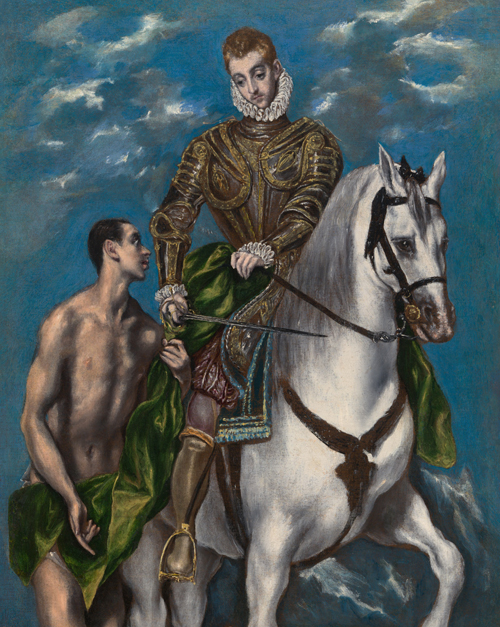
ABOUT THE ART
Theotokópoulos, Doménikos (El Greco). Saint Martin and the Beggar. 1597–1600. Oil on canvas. 110 × 63 cm (43 5/16 × 24 13/16 in.); Original painted surface: 107.5 × 58 cm (42 5/16 × 22 7/8 in.). Gift of Mr. and Mrs. Chauncey McCormick. Chicago: The Art Institute of Chicago.
This painting is a small replica of an altarpiece in the chapel of San José in Toledo, Spain. Saint Martin, seen here on horseback and wearing fashionable contemporary armor of the time, is pictured as he prepares to give a portion of his bright green cloak to the beggar.
Saint Martin of Tours – November 11th
On this day, Americans focus on Veterans Day, a day to celebrate those who have served in the armed forces. However, hidden deep within the day is the Christian witness of Saint Martin of Tours. The original name for Veterans Day was Armistice Day, as it is still known in Europe today. Armistice Day marks the end of World War I. This day was deliberately chosen because of its connection to Saint Martin.
Saint Martin is the patron saint of Europe and was a soldier himself. He served in the Roman army where he converted to Christianity. Tradition says that on a cold night, a beggar came and asked Martin for help. Martin, breaking protocol, took his sword and cut his uniform cape in half, giving it to the beggar. Later that night, Martin had a dream of Christ, who was wearing half a cloak, and then he realized that in serving those in need he also served Christ. When he awoke, his cloak had been miraculously restored to wholeness.
Later, the French army used a relic of Martin’s cloak for a special blessing on its military. The priests who guarded the cloak were called cappellanu, coming from the word cape. The word eventually covered all clergy who served in the armed forces. In English, they are known as chaplains. A similar thing happened to the temporary buildings where the cape was kept during war; they became known as chapels.
Saint Martin, soon after his conversion, chose peace and left his post in the Roman army, telling his commander that he was no longer in the Emperor’s army but the Lord’s. Miraculously avoiding the consequences of this decision, he became a monk and devoted his life fully to Christ. He was a bishop and evangelist spreading the good news all over Europe. Being born in Hungary, raised in Italy, a bishop in France, and a missionary to so many other places, it is easy to see why he became the patron saint of Europe and why his life was a good foundation for peace in Europe.
Another reason that St. Martin’s Day was so beloved is that it marked an old period of carnival. Carnival is a season of preparation for a fast. The most well-known celebration is Mardi Gras (Fat Tuesday) before Lent. But Advent, too, is a penitential season, traditionally marked with fasting. And it was once the same length—40 days not counting Sundays. This placed the great celebration on St. Martin’s Day, and it became known for feasting. The traditional foods to eat before the Advent fast were roast goose and all the fixings. In fact, it functioned much like the American celebration of Thanksgiving, a pre-Advent moment of feasting, celebrated with many of the same type of foods. But of course, most Americans substitute turkey for the goose, and cranberries for the currants.
For our feast of St. Martin’s Day, we are preparing some of our classic Thanksgiving recipes while also incorporating some traditional European recipes associated with St. Martin. We will also be celebrating those who have served our country and, like Martin did with his cloak, shared what they had with others.